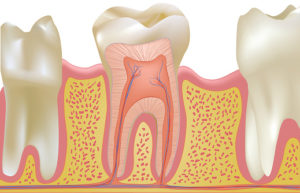Your teeth help you chew the food you love to eat, impact they way you speak, and affect how you look. Most adults have 32 teeth with 16 on both the top and bottom jaw. Teeth are the hardest substances in the human body, and consist of calcium, phosphorus, and other minerals. Unlike bones, teeth cannot grow back together if they are broken or decay. Understanding the importance of caring for your teeth starts with knowing the basic anatomy and structure of a tooth.
Root, Neck, and Crown
A tooth consists of three parts: root, neck, and crown. The root is hidden beneath the gums making up nearly two-thirds of the tooth. The neck is the region between the root and the crown. The visible part of the tooth is the crown; this is the surface area involved in chewing food. If the crown of a tooth is broken or decayed, a dental procedure can be used to restore the crown.
Hard and Soft Tissues
A tooth is made up of hard and soft tissues. There are three hard tissues known as the enamel, cementum, and dentin. The pulp is the main soft tissue of the tooth.
The enamel is the hard tissue that covers the crown and is the hardest layer. Enamel is mainly made up of calcium phosphate minerals. After the enamel is formed, there is little mineral turnover during life. Therefore, developed enamel is not considered a “living” tissue.
Cementum, also known as cement, covers the root part of a tooth. Cementum is softer than enamel and made up of mineralized connective tissues that aid in holding a tooth in place. Strands of tissue from surrounding bone known as periodontal ligaments also connect the root of a tooth to its socket.
Dentin is under both the enamel and cementum layers. Although dentin is considered a hard tissue, it is more porous than the other two hard tissues to allow nutrients to pass through. When the enamel covering is damaged, heat and cold or acid foods can bypass the dentin layer to stimulate nerves inside the tooth causing sensitivity.
Under the dentin layer is the pulp cavity, which contains the main soft tissue known as pulp, or the “living” portion of a tooth. The pulp is the inner center of a tooth and contains nerves, blood vessels, and connective tissues. The root canal is the pulp cavity inside the root portion of a tooth that serves as the passageway for the nerves and blood vessels.
Are you looking to get your teeth cleaned? Are you interested in learning about crown restoration options? Then contact California Dental Group at 800-407-0161 to set up an appointment.


